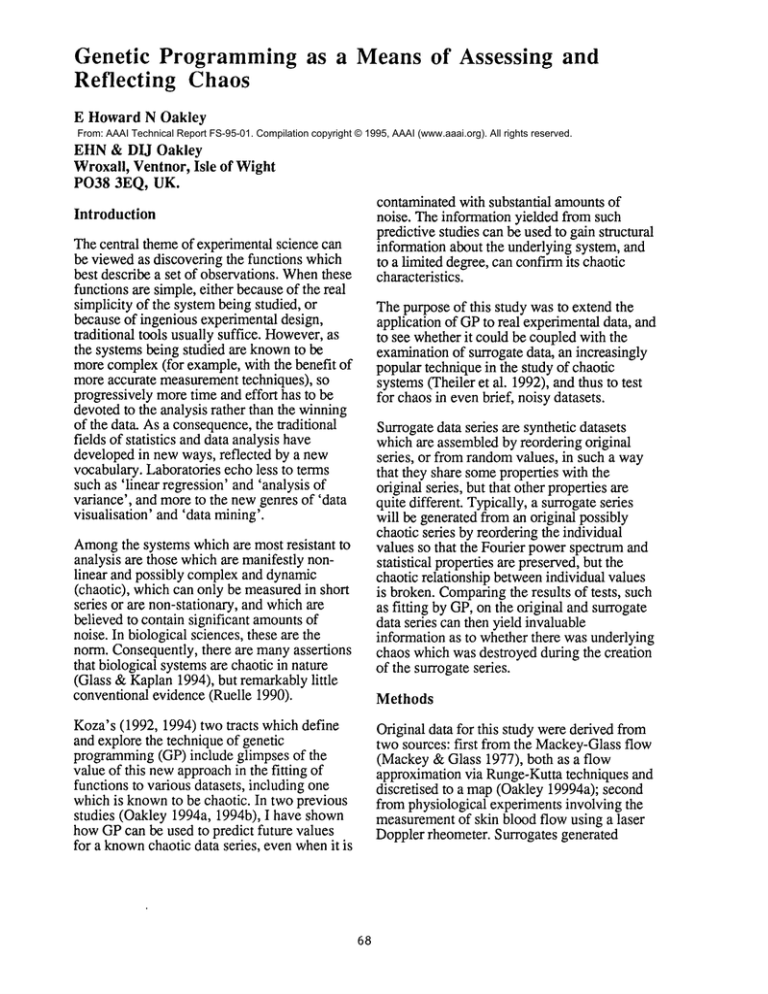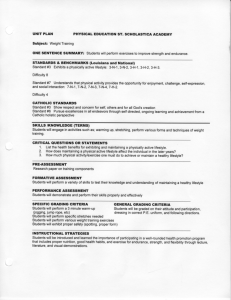
Genetic Programming as a Means of Assessing
Reflecting Chaos
and
E Howard N Oakley
From: AAAI Technical Report FS-95-01. Compilation copyright © 1995, AAAI (www.aaai.org). All rights reserved.
EHN& DIJ Oakley
Wroxall, Ventnor, Isle of Wight
PO38 3EQ, UK.
Introduction
Thecentral themeof experimentalscience can
be viewedas discovering the functions which
best describe a set of observations. Whenthese
functions are simple, either becauseof the real
simplicity of the systembeing studied, or
because of ingenious experimentaldesign,
traditional tools usually suffice. However,as
the systems being studied are knownto be
morecomplex(for example,with the benefit of
moreaccurate measurementtechniques), so
progressively moretime and effort has to be
devotedto the analysis rather than the winning
of the data. As a consequence,the traditional
fields of statistics and data analysis have
developed in newways, reflected by a new
vocabulary. Laboratories echo less to terms
such as ’linear regression’ and ’analysis of
variance’, and moreto the newgenres of ’data
visualisation’ and ’data mining’.
Amongthe systems which are most resistant to
analysis are those whichare manifestly nonlinear and possibly complexand dynamic
(chaotic), whichcan only be measuredin short
series or are non-stationary, and whichare
believed to contain significant amountsof
noise. In biological sciences, these are the
norm. Consequently,there are manyassertions
that biological systemsare chaotic in nature
(Glass & Kaplan1994), but remarkablylittle
conventional evidence (Ruelle 1990).
contaminatedwith substantial amountsof
noise. The information yielded from such
predictive studies can be used to gain structural
information about the underlying system, and
to a limited degree, can confirmits chaotic
characteristics.
Thepurposeof this study wasto extend the
application of GPto real experimentaldata, and
to see whetherit could be coupledwith the
examinationof surrogate data, an increasingly
popular techniquein the study of chaotic
systems(Theiler et al. 1992), and thus to test
for chaos in evenbrief, noisy datasets.
Surrogatedata series are synthetic datasets
whichare assembledby reordering original
series, or from randomvalues, in such a way
that they share someproperties with the
original series, but that other propertiesare
quite different. Typically,a surrogateseries
will be generatedfrom an original possibly
chaotic series by reordering the individual
values so that the Fourier powerspectrumand
statistical propertiesare preserved,but the
chaotic relationship betweenindividual values
is broken. Comparingthe results of tests, such
as fitting by GP,on the original and surrogate
data series can then yield invaluable
information as to whetherthere wasunderlying
chaos which wasdestroyed during the creation
of the surrogateseries.
Methods
Koza’s (1992, 1994) two tracts which define
and explore the techniqueof genetic
programming(GP) include glimpses of the
value of this newapproachin the fitting of
functions to various datasets, including one
whichis knownto be chaotic. In two previous
studies (Oakley 1994a, 1994b), I have shown
howGPcan be used to predict future values
for a knownchaotic data series, evenwhenit is
Original data for this study were derived from
two sources: first from the Mackey-Glassflow
(Mackey& Glass 1977), both as a flow
approximationvia Runge-Kuttatechniques and
discretised to a map(Oakley19994a); second
from physiological experimentsinvolving the
measurementof skin blood flow using a laser
Doppler rheometer. Surrogates generated
68
Data series
number
mean
variance
Mackey-Glass flow
no
516
0.8767
0.0839
surrogate
Mackey-Glass map
no
512
0.8838
no
various
approx 0.8
0.0585
approx 0.08
Blood flow 1
yes
513
163.7
4884.6
surrogate
Blood flow 2
yes
512
102
166.1
3324.5
49.5
488.1
76
222.3
2723.0
yes
Blood flow 3
Table 1: Characteristics of the data series used in this study.
accordingto the first methodof Theiler et al.
(1992), which possess the sameFourier power
spectrumand statistics, wereused of each
series as well. Themaincharacteristics of the
different series are givenin Table1.
protected fromzero divide errors), together
with error-protected sine, cosine and
exponentiation to the powerof 10 (a necessary
componentfor sufficiency for series involving
the Mackey-Glassmap).
For each data series, GPwas performedusing
Koza’s Simple Lisp code (Koza 1992) under
Macintosh Common
Lisp 2.0.1 running on an
Apple MacintoshIIci with a Radius Rocket
68040accelerator. Settings were those used in
previous studies in this series (Oakley1994b),
in brief using a rampedhalf-and-half generation
methodto create initial populationsof size 100
to 1000. Followingthis, a fitness proportionate
selection methodwas used with fitnessproportionate reproductionfraction 0.1,
crossover at any point fraction 0.2, and
crossover at function points fraction 0.7. The
maximum
depth of newindividuals was 6,
maximum
depth of new subtrees for mutants 4,
and maximum
depth of individuals after
crossover 17.
Rawand standardised fitness were taken as the
averageover the fitness cases of the squared
error betweenpredicted and actual points.
However,for the purposes of comparisons, the
normalised meansquared error (Gershenfeld
Weigend1994) wasderived from this, as the
standardised fitness divided by the sample
varianceof the actual points in the prediction
window.
Theterminal set wasthe effectively timeembeddeddata series, in most cases using
valuesat time steps 1, 2, 3, 4, 5, 6, 11, 16,
21, and 31 prior to the value being predicted,
together with randomreal numericconstants.
The aim of S-expressionsin the population of
each run wasto predict future values of the
series, up to 60 steps into the future. Whenever
the length of a data series permitted,this was
performedin multiple non-overlapping
windows.Thefunction set consisted of the
four basic arithmetic operators (with divide
69
Runswere performed over several days,
including a rangeof different populationsizes
from 100 to 1000, over 51 and 101 generations
withoutterminationcriteria. Thefittest Sexpression in each individual run was
recorded,together with details of it fitness and
generation.
Results
Prediction error, as gaugedby the normalised
meansquared error, for the Mackey-Glassflow
wassimilar to that reported earlier (Oakley
1994a)for its discretised map,and increased
with increasing duration of prediction.
However,whilst errors for the flow and its
surrogate were similar for brief predictions (30
steps into the future), they rose
disproportionatelyin the case of the surrogate
series, to reach three times the error at 30 when
4°°
t
35O
300
250
200
150
i
100 I
0
I
10
20
I
40
I
50
V
I
60
I
70
Figure
1 Anexperimentaldata series (dotted) with the forecast series (solid)
superimposed.Thevertical line marksthe point at whichpredicted values begin for
the latter.
prediction length had only doubledto 60.
Errors from the experimentaldata series were
of similar magnitudeas those from the MackeyGlass flow. Figure 1 showsone of the better
examplesof’a fit S-expressionpredicting blood
flow data.
S-expressionsevaluatedbefore the fittest
emergedin that run, and for a given groupof
runs (with the samepopulation size and
numberof generations) the average numberof
S-expressionsevaluatedfor the fittest to
emergein that group of runs. Both of these
increased with increasing numberof SIn both the Mackey-Glassflow and
expressions evaluated, and with reducing
experimentaldata series, increasing the number prediction error.
of individuals used in each GPrun (by
increasing the populationsize and/or the
The behaviourof surrogate data series was
numberof generations) generally led to reduced quite distinct. In the case of the Mackey-Glass
predictionerrors. Typically,in the case of the
flow surrogate, a few very simple SMackey-Glassflow, an increase in the number expressions recurred time after time and
of individuals used from 5100 to 50500
dominatedruns. Theywere typically found in
(approximatelytenfold) resulted in a halving
the initial populationor after relatively few
the predictionerror;, the magnitude
of this effect generations, so that complexS-expressions
in experimentaldata series wasreduced.
rarely appearedamongthe fittest (indeed, they
failed to evolve within populations). There was
Studyof the complexityof the fittest Sthus no reduction in prediction error with
expressions, estimated using the simple metric
increasing numberof S-expressions evaluated,
of counting left parentheses, and the numberof
and the average S-expression complexityand
individualsrequiredto arrive at the fittest
numberof generations required to find the
demonstratedthe expectedinterrelationships.
fittest S-expressionremainedfLxedand low as
Fitter S-expressionstended to be more
population sizes and numbersof generations
complicatedand to require moreindividuals
increased. Indeed, the average generationof the
(i.e. higher numbersof generations as well as
fittest S-expressionactually reducedas the
greater populationsizes) for themto be
populationsize increased.
generated. Twometrics which give a good feel
for this effect are the changein the numberof
70
It is interesting to speculatethat populationsof
S-expressions in genetic programmingcometo
reflect the nature of the fitness landscape,and
thus the complexityof the data whichthey are
trying to fit. This is best seen in the simpleand
artificial case here of the Mackey-Glass
flow.
Usingreal chaotic data, the S-expressionsin
the evolving populations tended to become
complicatedand rich in their composition,in
responseto their varied fitness landscape. In
contrast, those of the surrogate series generated
from the Mackey-Glassflow quickly came to
reflect their less varied landscape.
Discussion
The efficacy of genetic programming
as a
meansof predicting data from short, noisy,
possibly chaotic series has been demonstrated
again. This has important consequencesfor
those searching for a technique whichcan be
used to examinea wide range of experimental
data: GPis a prime candidate whichhas a
numberof significant advantagesover other
techniques.
First, GPas a technique does not need to make
any underlyi’ng assumptionsabout the nature of
the data with whichit is presented.Particularly
whenused in its original Common
Lisp
implementation,it is remarkablyeasy to
provide for almost any data input and operator
type in GP. This contrasts with other popular
alternatives such as neural networksand other
evolutionary computingapproaches, in which
structural considerations dominatethe outcome.
Conclusion
This series of studies (Oakley1994a, Oakley
1994b) has shown how genetic programming
can be used to performa numberof vital
functions in the analysis of experimentaldata.
Theseinclude systemidentification, prediction,
and the distinction betweenchaotic and
stochastic systems. It only remainsto package
the technique into a form whichmakesit
accessibleto the practitioner.
Second, GP requires a minimal programming
effort, although this does in consequencemake
it morecomputationallyintensive. In scientific
computing,this spares the most expensive,
humanresource. Third, as has been remarked
before (Oakley 1994b), GPavoids the trap
overfitting data in the face of noise. It also
yields structural information,and is an effective
meansof systemidentification (Iba et al. 1993,
Oakley 1994a).
References
CouplingGPwith the use of surrogate data
series opens’upa rich rangeof possibilities
beyondthese. Studying the progress of
multiple GPruns on actual and surrogate
datasets appears to discriminate betweenthe
two. This suggests that the rich ever-improving
populations of S-expressions found in some
real data reflect non-linearity, evenchaos,
within those data. Here, the fitness landscapeis
varied and continuing evolutionary search
yields higher peaksof fitness.
Gershenfeid N A WeigendA S 1994 The
future of time series: learning and
understanding Time Series Prediction:
Forecasting the Future and Understandingthe
Past ed A S WeigendN A Gershenfeld
(Reading, Mass: Addison-Wesley)1-70
Glass L Kaplan D 1994 Complexdynamics in
physiology and medicine Time Series
Prediction: Forecasting the Future and
Understanding the Past ed A S WeigendN A
Gershenfeld (Reading, Mass: Addison-Wesley)
513-528
Iba H Kurita T de Garis H Sato T 1993
Systemidentification using structured genetic
algorithms Proceedingsof the Fifth
International Conferenceon Genetic
Algorithms ed S Forrest (San Mateo,
Cal: Morgan Kaufmann)
In contrast, the surrogate datasets appear
dominatedby the shallow and featureless
landscapestypical of stochastic processes. A
few prominentpeaks of fitness are found
quickly, and further evolutionarysearch fails to
improve on them.
71
Koza J R 1992 Genetic Programming.On the
Programmingof Computers by Means of
Natural Selection (Cambridge, Mass: MIT
Press)
Koza J R 1994 Genetic ProgrammingH:
Automatic Discovery of Reusable Programs
(Cambridge, Mass: MITPress)
MackeyMC Glass L 1977 Oscillation and
chaos in ph3/siological control systemsScience
197 287-289
Oakley E H N 1994a Twoscientific
applications of genetic programming:stack
filter and non-linearequationfitting to chaotic
data Advances in Genetic Programminged K
E Kinnear (Cambridge, Mass: MITPress)
369-389
Oakley E H N 1994b The application of
genetic programming
to the investigation of
short, noisy, chaotic data series LectureNotes
in ComputerScience: Evolutionary Computing
ed T C Fogarty (NewYork, NY:Springer
Verlag)
Ruelle D 1990Deterministic chaos: the science
and the fiction Proc. Roy. Soc. Lond. A 427
241-248
Theiler J Galdrikian B Longtin A EubankS
FarmerJ D 1992Usingsurrogate data to detect
nonlinearity in time series NonlinearModelling
and Forecasting ed MCasdagli S Eubank
(RedwoodCity, Cal: Addison-Wesley)
163-188
72







